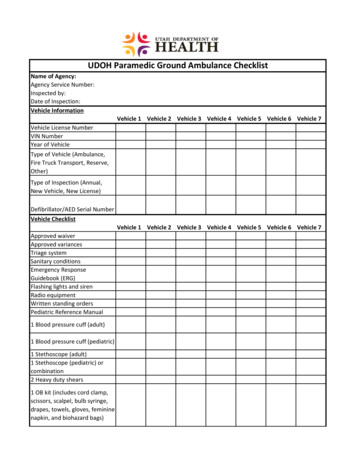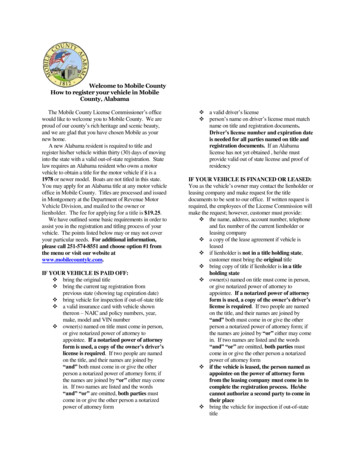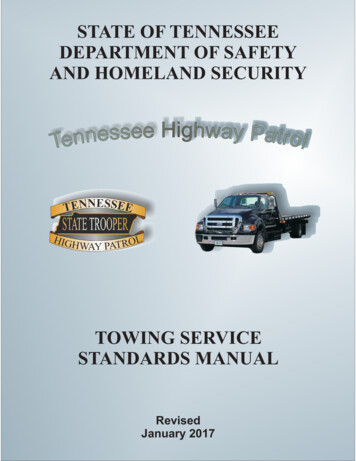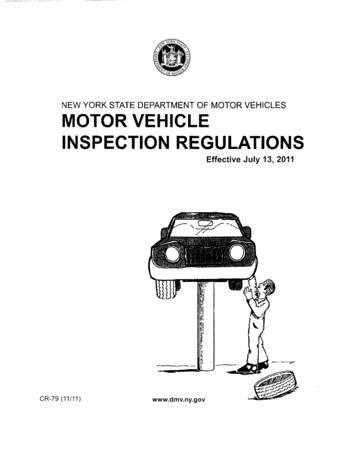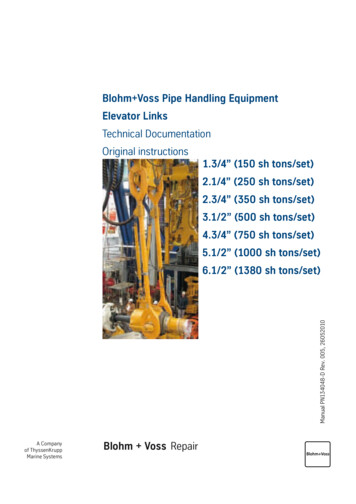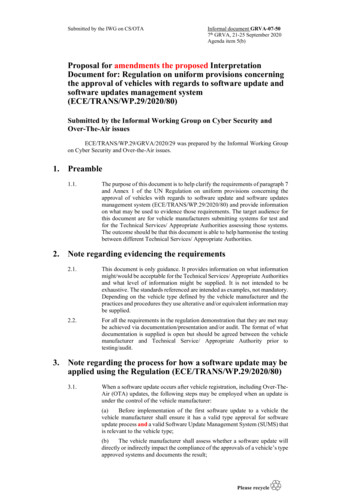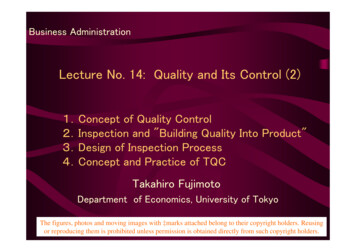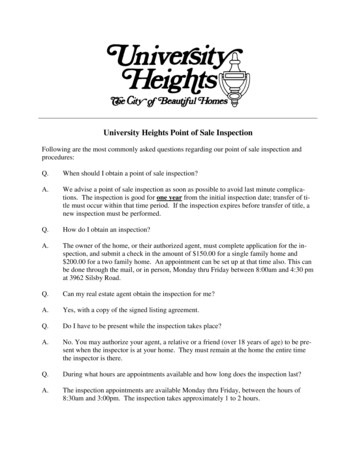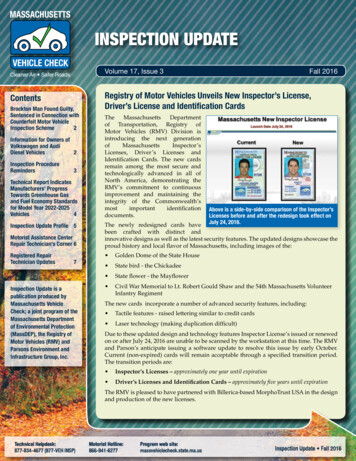
Transcription
MASSACHUSETTSINSPECTION UPDATEVEHICLE CHECKVolume 17, Issue 3Cleaner Air Safer RoadsContentsBrockton Man Found Guilty,Sentenced in Connection withCounterfeit Motor VehicleInspection Scheme2Information for Owners ofVolkswagen and AudiDiesel Vehicles2Inspection ProcedureReminders3Technical Report IndicatesManufacturers’ ProgressTowards Greenhouse Gasand Fuel Economy Standardsfor Model Year 2022-2025Vehicles4Inspection Update Profile 5Motorist Assistance CenterRepair Technician’s Corner 6Registered RepairTechnician Updates7Inspection Update is apublication produced byMassachusetts VehicleCheck; a joint program of theMassachusetts Departmentof Environmental Protection(MassDEP), the Registry ofMotor Vehicles (RMV) andParsons Environment andInfrastructure Group, Inc.Fall 2016Registry of Motor Vehicles Unveils New Inspector’s License,Driver’s License and Identification CardsTheMassachusettsDepartmentof Transportation, Registry ofMotor Vehicles (RMV) Division isintroducing the next generationofMassachusettsInspector’sLicenses, Driver’s Licenses andIdentification Cards. The new cardsremain among the most secure andtechnologically advanced in all ofNorth America, demonstrating theRMV’s commitment to continuousimprovement and maintaining theintegrity of the ts.Above is a side-by-side comparison of the Inspector’sLicenses before and after the redesign took effect onJuly 24, 2016.The newly redesigned cards havebeen crafted with distinct andinnovative designs as well as the latest security features. The updated designs showcase theproud history and local flavor of Massachusetts, including images of the: Golden Dome of the State House State bird - the Chickadee State flower - the Mayflower Civil War Memorial to Lt. Robert Gould Shaw and the 54th Massachusetts VolunteerInfantry RegimentThe new cards incorporate a number of advanced security features, including: Tactile features - raised lettering similar to credit cards Laser technology (making duplication difficult)Due to these updated design and technology features Inspector License’s issued or renewedon or after July 24, 2016 are unable to be scanned by the workstation at this time. The RMVand Parson’s anticipate issuing a software update to resolve this issue by early October.Current (non-expired) cards will remain acceptable through a specified transition period.The transition periods are: Inspector’s Licenses – approximately one year until expiration Driver’s Licenses and Identification Cards – approximately five years until expirationThe RMV is pleased to have partnered with Billerica-based MorphoTrust USA in the designand production of the new licenses.Technical Helpdesk:877-834-4677 (877-VEH INSP)Motorist Hotline:866-941-6277Program web site:massvehiclecheck.state.ma.usInspection Update Fall 2016
Brockton Man Found Guilty, Sentenced inConnection with Counterfeit Motor VehicleInspection SchemeSource: http://www.stockmonkeys.com/Attorney General Maura Healey announced on July 1,2016, that a Brockton man was convicted and sentenced inconnection with running a counterfeit inspection schemewith his father out of their Dorchester auto shop.Following a three-day trial, a Suffolk Superior Court juryfound 30-year old Tommy Sostre of Brockton guilty ofcharges related to printing and distributing counterfeitinspection stickers.Judge Linda Giles sentenced Sostre to three years ofprobation with the conditions that he surrender allinspection station and inspector licenses, and not performinspections while on probation. Judge Giles also orderedthat Sostre pay a 2,000 fine.“Emissions tests are designed to keep our roads safe and ourair clean, but this defendant and his father ran an inspectionscam that created and sold sham inspection stickers for carsthat otherwise would not have passed,” said AG Healey.“This scheme intentionally violated the law that protectsthe air we breathe and put the safety of those who use ourroads at risk.”“Fraudulent acts, such as falsifying inspection stickers,cut to the heart of the emissions inspection program’smission to protect public health and the environment,” saidMassachusetts Department of Environmental Protection(MassDEP) Commissioner Martin Suuberg. “We willcontinue to aggressively pursue violators who attempt tocompromise this important air quality program.”“Safety and emissions inspection rules are in place to protectthe public and the environment. This verdict helps ensurethe safety of all those who travel on the Commonwealth’sroadways,” said Registrar of Motor Vehicles Erin C.Deveney. “We appreciate and share the commitment of ourlaw enforcement and environmental partners to detect andend this type of fraudulent activity.”Sostre’s father, 63-year old Jose Sostre of Avon, ran thescheme with him and pleaded guilty in August 2015 tosimilar counterfeit charges, as well as gun possessionwithout a Firearms Identification (FID) Card. Mr. Jose Sostrewas sentenced to one year in the House of Correction, 90days to serve followed by a three-year probationary periodin connection with the scheme. He was required to pay a 5,000 fine, surrender his motor vehicle inspector’s licenseand is not to conduct any motor vehicle inspections for theterm of his probation.In the spring of 2013, the AG’s office began investigatingthis case after it was referred by MassDEP and the RMV.Working in conjunction with those agencies as wellas the Massachusetts Environmental Police, the AG’sinvestigation revealed that, on specific dates in September2013, Tommy and Jose Sostre created and issued counterfeitinspection stickers at Tony’s Auto Repair and Body Shopin Dorchester, where they worked as licensed inspectors.Specifically Tommy and Jose Sostre created fake “passing”inspection stickers for vehicles that had failed emissionstesting. The investigation further revealed that Jose Sostreillegally possessed a firearm at the auto shop withouthaving a FID card.Tony’s Auto currently is no longer authorized to providemotor vehicle inspections.This investigation was handled by the MassachusettsEnvironmental Crimes Strike Force, which is comprisedof prosecutors from the Attorney General’s Office,Massachusetts Environmental Police Detectives assignedto the AG’s Office, and investigators and engineers fromMassDEP who investigate and prosecute crimes that harmor threaten the state’s water, air, or land and that pose asignificant threat to human health.Information for Owners of Volkswagen andAudi Diesel VehiclesIn June, Volkswagen entered into a multibillion dollar settlement to partially resolvealleged federal Clean Air Act violationsinvolving the sale of model year 2009-2015Volkswagen and Audi diesel cars equippedwith 2.0 liter engines. These vehicles hadeither software or hardware known as “defeatdevices” installed to circumvent U.S. EnvironmentalProtection Agency (EPA) emissions standards for nitrogenoxides (NOx).This settlement includes affected vehicle buybacks or leaseterminations, vehicle retrofits, and billions of dollars infines. Please visit https://www.epa.gov/vw to read moreabout this settlement, to find out the latest informationabout this ongoing case, and refer anyone who would likethe most current information to EPA’s website.Inspection Update Fall 20162
Inspection Procedure Reminderswebsite at http://www.massvehiclecheck.state.ma.us/reprint vir.html. You can even attach a photo of thecommercial vehicle’s door jamb GVWR sticker to theVIR for your own records.ffCommercial Vehicle Inspection RemindersThe Massachusetts Department of Transportation Registryof Motor Vehicle (RMV) Division would like to remind allcommercial inspection stations (License Classes B, C, Dand E) that you are only permitted to inspect commercialvehicles that fit inside designated inspection bays. Class Bstations must have a minimum of a 30-foot long by 12-footwide inspection bay. Class C, D and E stations must havea minimum of 45-foot long by 14-foot wide inspection bay.If the vehicle you are asked to inspect does not fit in yourinspection bay, you are required to turn that vehicle away.Similarly, RMV reminds all Class B commercial inspectionstations to only conduct inspections on vehicles that you arelicensed to inspect. If the vehicle you are asked to inspecthas a Gross Vehicle Weight Rating (GVWR) above 26,000pounds, you are required to turn that vehicle away. If thevehicle undergoing inspection has a GVWR that is close tothe 26,000 pound cutoff, here are few tips to ensure you candocument your compliance with this requirement during aRMV station audit: Always use the posted GVWR that is on the stickerin the door jamb, not the GVWR that is on theregistration document. Record the actual GVWR in the Safety InspectionNotes field at the end of the inspection process, sothere is proof that you confirmed the GVWR of thevehicle. Print a copy or photocopy the Vehicle InspectionReport (VIR), which includes the Safety InspectionNotes field. You can reprint VIRs from the programFor more reminders about the importance of proper GVWRentry, see page 6 of the Fall 2011 Inspection Update andpages 2 and 3 of the Fall 2015 newsletter. Both are availableon the program website at s/11FALL.pdf and s/15FALL.pdf.ffEmissions Inspection Regulation UpdateIn August 2016, the Massachusetts Department ofEnvironmental Protection published an update to 310CMR 60.02 Massachusetts Motor Vehicle EmissionsInspection and Maintenance Program. This regulationincludes updated requirements for kit vehicle emissionsinspections in section (8)(e) and (12)(c) and RegisteredRepair Technicians specializing in diesel vehicle repairs insection (22)(b).A copy of this new regulation can be found regulations/310cmr60.pdf. For more information abouthow this regulation applies to kit vehicles, see page 5 ofthe Spring 2014 Inspection Update. For more informationabout kit and specialty vehicle inspections, see pages 6and 7 of the Spring 2012 newsletter. Both are available onthe program website at s/14SPRING.pdf and s/12SPRING.pdf.If you would prefer to receive your quarterly newsletters electronically by e-mail, contact us via the following methods:Email us at: info@massvehiclecheck.comPlease e-mail me this newsletter at the following e-mail address:NameAddressCity, State, ZIPInspector ID and/orRepair Technician IDAlternatively, you can:Call us at 877-834-4677, fax us at 866-873-8932, or write to us at: Massachusetts Vehicle Check Program, 55 Messina Drive, Unit C,Braintree, MA 02184Inspection Update Fall 20163
Technical Report Indicates Manufacturers’ Progress Towards GreenhouseGas and Fuel Economy Standards for Model Year 2022-2025 VehiclesWASHINGTON – Over the summer, the U.S. Departmentof Transportation (DOT), the U.S. Environmental ProtectionAgency (EPA), and the California Air Resource Board (CARB)issued a mid-term evaluation of the National Program forgreenhouse gas emissions and fuel economy standards forlight duty cars and trucks by releasing a draft TechnicalAssessment Report (TAR) for public comment. The releaseof the TAR delivers on a commitment that EPA made in 2012as part of the rulemaking establishing a National Programfor the 2017-2025 period. The draft TAR covers model years(MY) 2022-2025.The draft TAR shows that automotive manufacturers areinnovating and bringing new technology to market at a rapidpace, and that they will be able to meet the MY 2022-2025standards established in the 2012 rulemaking with a widerange of cost-effective technologies. Moreover, it indicatesthat these standards can be achieved by relying primarilyon advanced gasoline vehicles. The report also shows thatmanufacturers will be able to meet the stricter standardsat a similar or even lower cost than was anticipated in the2012 rulemaking, with substantial savings on fuel costs forconsumers.“Today’s draft report shows that automakers are developingfar more technologies to improve fuel economy and reducegreenhouse gas emissions, at similar or lower costs, thanwe thought possible just a few years ago. And they areadopting these fuel-saving technologies into their fleets evenfaster than anticipated,” said Janet McCabe, acting assistantadministrator for EPA’s Office of Air and Radiation. “This issimply great news for consumers, manufacturers, workersand the climate.”“Automakers have already implemented new technologiesthat are saving American drivers money and cut national fuelconsumption and carbon emissions today,” said NationalHighway Traffic Safety Administrator Dr. Mark Rosekind.“The draft report supports that the administration’s fueleconomy program can continue to incentivize innovation andreduce fuel consumption while also ensuring that consumerscan continue to choose the vehicles they want to drive. Theagencies welcome public comments to assist the agencies’analysis and decision making.”“After almost four years of close collaboration on the draftTechnical Assessment Report with our federal partners, theconclusions are clear: costs are lower for many technologiesthan we originally thought, market uptake is strong, andexpected consumer benefits remain high,” said CARB ChairMary D. Nichols.The National Program is designed to enable consumers tochoose the car or truck they want, while ensuring that thevehicles they select will reduce carbon emissions and saveon fuel costs. The program was developed jointly by theEPA and DOT, in coordination with CARB, and applies topassenger cars and light duty trucks through model year2025. It requires manufacturers to improve average fuelefficiency and reduce average greenhouse gas emissions overtime.In recent years, and responding to the standards establishedin the National Program, automakers have been rapidlyadopting fuel-efficient technologies like turbo charging,engine downsizing, more sophisticated transmissions, vehicleweight reduction, aerodynamics, and idle stop-start, alongwith improved accessories and air conditioning systems.There are over 100 car, SUV, and pick-up truck versions onthe market today that already meet 2020 or later standards,suggesting that automakers should be well-positioned tomeet future average standards through additional applicationof those technologies.Today’s draft report is the first of several steps the agencieswill take as part of assessing the standards for MY 2022-2025vehicles. The report itself is not a rulemaking and does notchange any of the existing requirements under the existingNational Program.The National Program does not set a single fuel economytarget number for all vehicles, but instead establishes separatefootprint-based standards for passenger cars and light trucks.A manufacturer’s compliance obligation depends on the mixof vehicles that it produces for sale in each model year – ifa manufacturer produces mostly larger vehicles, its averagestandard will be less stringent than if it produces mostlysmaller vehicles, reflecting the reality that smaller vehiclesoften have better fuel economy and lower carbon emissionsthan larger vehicles. This approach ensures that consumerscan continue to choose from the full range of fuel efficientvehicles on the market, and at the same time, it improvesefficiency and emissions for all types of vehicles.While the Draft TAR analysis focuses on the MY 2022-2025standards, the report also shows that auto manufacturersover-complied with the standards for each of the first threeyears of the program, and in 2014 outperformed the standardsby 1.4 miles per gallon. This occurred during a period duringwhich the automotive industry has seen six consecutive yearsof sales increases and a new all-time sales record in 2015,reflecting positive consumer response to vehicles complyingwith the standards.For more information on this announcement, visit: n Update Fall 20164
Inspection Update Profile Brian Hohmann, OwnerAccurate Automotive, Burlington, MAQ: WhatservicesdoesAccurate Automotive offer?A: Accurate Automotive istruly a dealer alternative. Wedo everything from registeredemissionsrepair,brakeservice, tire repairs to engineand transmission repair, andwe even offer our customersloaner vehicles.Brian Hohmann, OwnerQ: What are your roles andresponsibilities as owner?A: Being an owner allowsme to wear many hats. I start each day at 6:30 a.m. andleave by 6:30 p.m. During that time, I’m behind thescenes doing marketing, accounting, forecasting, andbuilding and implementing new systems. I am alsoat the front counter, actively involved with customerservice, vehicle repairs, and making sure the day-today operations run smoothly.Q: How many employees do you have? What are theirroles?A: My team consists of five full-time employees and fivepart-time employees, most of whom have worked atAccurate Automotive for over 10 years. My serviceadvisor/technician, Chris Jenson, has been here forover 18 years.Q: How did you get your start in the automotive industry?What made you want to open your own business?A: I started pumping gas at a local Shell station in 1987and have been hooked ever since! That job helped meget my start working in multiple automotive positions.I have since worked at an engine machine shop, towingcompany, muffler shop, multiple gas stations, and anew car dealer. I opened Accurate Automotive in Julyof 1994.Q: Have you attended any of the ongoing training? Howelse do you keep up with changes in vehicle technologyand emerging Industry technologies?A: I have attended many of the MAC Open Houses andalso regularly attend mechanical and business trainingsthroughout the country. Once I find a great trainer,traveling to attend their workshops is always worththe effort, and the networking is invaluable. Someof my favorite instructors include: Gary Machiros,Automotive Training Group (ATG); John Thorton,Automotive Seminars, Inc.; and Scot Manna, a pastACDelco Technician of the Millennium.Q: Are you a Registered Repair Technician (RRT)?A: Yes, I am a Registered Repair Technician.Q: How has being a Registered Repair Technician (RRT)helped your business?A: Being a Registered Repair Technician requires me to stayon top of my game. My company has really benefittedfrom this through the purchasing of factory scan toolsand hands-on training. This investment has raised thelevel of service we are able to provide. I never haveto send customers anywhere else to get their vehicleserviced because we do it all.Q: What are some of your most challenging vehiclerepairs?A: Network faults can be a challenge, especially when thevehicle has multiple networks. These are my favoritetypes of repairs. I know some repair technicians arevexed over diagnosing intermittent vehicle issues, but Iactually prefer them.Q: What should motorists begin to do to ready theirvehicles for fall?A: If I could offer one piece of advice in preparation forthe fall, I would tell motorists to check the tread depthon their vehicle’s tires. Good tires can be the differencebetween avoiding an accident or being involved in one.Overall, I tell my customers to stay proactive abouttheir car maintenance, so they won’t be stuck in anyemergency situations on the side of the road.Q: How do you advertise your business?A: To be honest, the most effective form of advertising hasbeen and continues to be “word of mouth.” If you trulydo all you can for your customers, word does travel.We have been voted Burlington’s “Best of the Best” forautomotive repair for the past 14 years.Q: What is your business motto?A: Our motto is “Follow the Golden Rule, treat others asyou want to be treated.” Technology can be intimidatingwhen it comes to auto repair, so it is our job to make thisless so for our customers.Inspection Update Fall 20165
Motorist Assistance Center Repair Technician’s Cornerff Permanent Diagnostic Trouble CodeQuestions and AnswersRepair Technician Question: I recently repaired a Subaruand then cleared codes using my Snap-on Verus on-boarddiagnostics (OBD) scan tool. I checked afterwards and wassure that all codes were cleared. However, when using aquick-checker (a hand-held code reader) on the road test,the code was still there no matter what I did, includingdisconnecting the battery. At the same time, I used theVerus to check for codes on generic and manufacturespecific modes, and there are no codes at all. Is there somereason that a generic scan tool would still see the code untilit runs monitors? I have never had this happen before. Doyou know what is happening?MAC Answer: This is normal, and not specific to justSubaru. Starting with model year 2010, emissions-relatedcodes are required to be retained in the OBD system untilthe monitor for that code runs and passes, possibly multipletimes. These codes are stored as permanent diagnostictrouble code (DTC). A basic code reading tool may not beable to tell the difference between current and permanentcodes, but most diagnostic scan tools can. Here is what youneed to know about permanent DTCs.What are Permanent DTCs?A permanent DTC is a DTC that corresponds to a MalfunctionIndicator Lamp (MIL)-on DTC and is stored in non-volatilerandom access memory (NVRAM). A permanent DTCcan only be erased by the OBD system itself and cannotbe erased through human interaction such as using a scantool or disconnecting the battery. Permanent codes will notcause the MIL to come on and they will not put the car intoa “more sensitive” mode.Permanent DTC implementation was phased-in beginningin 2010, and is required on all model year 2012 and newergasoline and diesel vehicles*. Mode 0A, also knownas Mode 10, was created, with NVRAM, to store thesepermanent codes. Memory storage capacity must store thedata from up to 4 codes, as well as misfire and fuel trimdata.When the Malfunction Indicator Light (MIL) is commanded“on” in a vehicle that supports permanent DTCs, the troublecode is stored as both a regular DTC and also as a permanentDTC. Permanent fault codes survive code-clear eventswith a scan tool (Mode 03), or loss of keep-alive-memory*Title 13, California Code of Regulations, Section 1968.2and 40 CFR Part 86.008-10 and 86.010-2. Beginning withMY 2010, Permanent-DTCs were phased-in. Fifty percentof the fleet was required to be permanent-DTC compliantin MY 2010; 75% in MY 2011, and 100% in MY 2012. Thisrequirement applied to both the gasoline and diesel fleets.(KAM) from battery disconnect. Permanent fault codes canonly be erased in the Powertrain Control Module (PCM) bythe OBD system.What are Permanent DTCs Used For?The primary value for a permanent DTC to repair techniciansis for diagnosing a vehicle with a known emission concernwhen the MIL is off and there are no current DTCs. Thepermanent code is stored to help you with stubbornmonitors or provide a diagnostic path when you do notknow the vehicle’s repair history. The concept was originallyproposed by one of the vehicle manufacturers as a way toaddress some of the inspection and maintenance (I/M)issues that OBD systems were having ranging from hardto set emission monitor readiness, readiness monitors notbeing selective between cars that had faults and those thatdid not, readiness monitors not being selective as to whatfault a car had, and to address people attempting to cheatthe I/M test by clearing codes and getting back through thetest before that particular monitor ran again and re-detectedthe fault.Permanent DTCs are similar to readiness monitors but havemore selective criteria. Readiness testing consists of onlyfive or six different monitors such as the catalyst, oxygensensor, EGR, etc. Readiness monitors do not cover the200 to 400 typical individual possible DTCs on a vehicle.Therefore, permanent DTCs cover every single individualDTC monitor. For example, if you had a DTC for an enginecoolant temperature sensor, it won’t be tied to any of thereadiness monitors, but it will have a permanent fault code.You might be able to get all of the readiness monitors toreset to ready/complete and still never see the ECT monitorset; in that case, the permanent code will be in the PCMuntil that ECT monitor actually runs.Clearing Permanent DTCsYou cannot clear a permanent code with a scan tool. Onlythe OBD system on the car itself can clear them once theexact diagnostics (DTC monitor) has run and passed. TheOBD system will erase a permanent fault code if and onlyif the OBD system determines that the malfunction thatcaused the permanent fault code to be stored is no longerpresent and is not commanding the MIL on.For example, suppose you repaired a vehicle with theMIL on and a regular fault code of P0420 Catalyst SystemEfficiency Below Threshold. If you were to use a scan tool toclear this DTC, the MIL would turn off, the confirmed codewould disappear, the readiness monitors would becomenot ready/incomplete, but the permanent code would stillbe stored in the PCM’s NVRAM. The permanent code willnot make the MIL come back on, but will stay in memoryuntil the monitor/diagnostic for P0420 has a chance to runagain and conclude that the system is passing (and erasethe permanent code) or failing (and store a confirmed codeand turn the MIL back on).Inspection Update Fall 2016 6
Motorist Assistance CenterRepair Technician’s Corner(Continued from page 6)It is important to use caution when looking at DTCs withyour scan tool(s). Be sure to determine how your scan toolis displaying the different types of pending, regular, andpermanent DTCs. There are regulations that dictate howeach one these code status types are to be set. However,a pending code is generally an indication of a fault thatonce confirmed a second time will turn to a regular code.A regular or hard code is an identified emission concernand will most likely turn the MIL on. Note: Most, but notall Pxxxx codes will turn the MIL on. Both pending andregular code types can be erased by a Mode 04 (Clear/Reset Stored Emissions Related Data) using the scan tool.The corresponding permanent DTC will still be viewable tothe scan tool because it is stored in the NVRAM.Reminder to InspectorsPlease do not clear codes when a vehicle comes in forinspection, either before or after the inspection hascompleted. In most cases, you have not helped yourcustomer through the inspection process. With the currentlevel of sophisticated vehicle technology, the chances ofthe code not returning are very slim. Additionally, whenyou clear any regular DTCs, you are erasing the diagnostictrail (fault code(s) and freeze frame information) that willprevent you or someone else from properly diagnosing andrepairing the vehicle.Registered Repair Technician UpdatesffSpring Training RecapIn June 2016, the Massachusetts Vehicle Check programoffered a Registered Repair Technician ongoing trainingmodule titled “Hybrid Vehicle DTCs.” Instructor Jerry “G”Truglia trained a total of 45 Registered Repair Technicianswho attended the trainings at four Motorist AssistanceCenters (MACs).ffOBD Diagnosis and Repair TrainingOn-Board Diagnostics (OBD) Diagnosis and Repair Trainingis designed for motor vehicle repair professionals who areseeking to become Massachusetts Registered EmissionsRepair Technicians.This class is open to all technicians, including those studyingto take the A8 Engine Performance or L1 Advanced EnginePerformance Specialist National Institute for AutomotiveService Excellence (ASE) tests. In other words, you donot need to be ASE-certified repair technician to take thiscourse.OBD Diagnosis and Repair Training is a 28-hour courseconsisting of 20 hours of classroom lecture and eight hoursof hands-on training and examination. The class providesfoundational information concerning the diagnosis andrepair of OBD-equipped vehicles. The course fee is 600.The next class is being offered in November.CoursesOfferedDates and TimesFall 2016Monday - Wednesday, November 7 - 9, 8:00 AM - 5:00 PMThursday, November 8, 8:00 AM - 12:00 PMThe application for this course is available at http://www.massvehiclecheck.state.ma.us/inspection ongoing.html. Ifyou have questions or need help signing up, please contactour Registered Repair Coordinator at (781) 794-2961.ff2016 Ongoing Training CoursesAll current Registered Emissions Repair Technicians arerequired to attend one four-hour ongoing training seminareach year to maintain their status in the MassachusettsVehicle Check Program. Parsons is offering the last 2016quarterly seminar from 6:00 PM to 10:00 PM at MotoristAssistance Centers (MACs) located across the state. If youhaven’t attended a quarterly seminar in 2016, you will needto attend this one to keep your technician status current.Ongoing TrainingSeminarFall 2016 –Domestic and AsianEVAP SystemsLocations and DatesBraintree MAC - November 7Pocasset MAC - November 8Shrewsbury MAC - November 21West Springfield MAC - November 22All training seminars for Registered Repair Technicians areoffered free of charge. The applications for these courses areavailable at: http://www.massvehiclecheck.state.ma.us/inspection ongoing.html.On June 7, 2016, Jerry “G” Truglia trained Cape Cod areatechnicians at the Pocasset Motorist Assistance Center on howto repair hybrid-electric vehicles with diagnostic trouble codes.Should you need help registering or have any questions,please contact our Registered Repair Coordinator at (781)794-2961. Space is limited to 35 technicians per class, soplease enroll as soon as possible to secure a place.Inspection Update Fall 20167
Inspection UpdateMassachusetts Vehicle Check ProgramPresorted First ClassUS PostagePaidPermit #112Carol Stream, IL55 Messina Drive, Unit CBraintree, MA 02184Commercial Inspection and Permanent Diagnostic Trouble Code Reminders Inside!Massachusetts Vehicle Check Program At A GlanceProgram at a GlanceCountFailure Rate1,297,1514.4%Violat
CMR 60.02 Massachusetts Motor Vehicle Emissions Inspection and Maintenance Program. This regulation includes updated requirements for kit vehicle emissions inspections in section (8)(e) and (12)(c) and Registered Repair Technicians specializing in diesel vehicle repairs in section (22)(b). A copy of this new regulation can be found online
